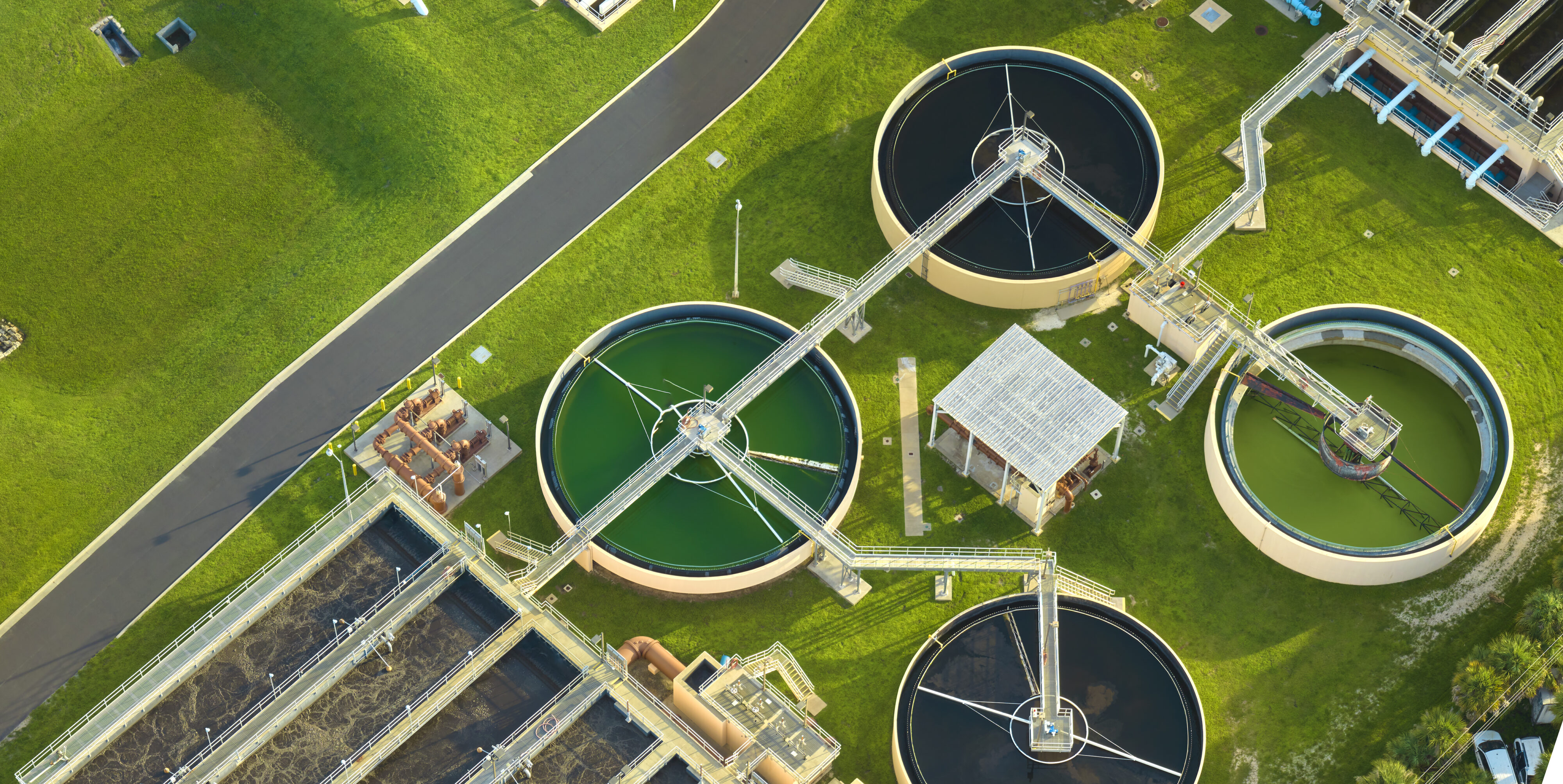Blog update 5/30/24: We want to thank the public for all the love and support of this work over...

Respiratory Virus Risk Reports
Comprehensive Insights for COVID-19, Influenza, and RSV
COVID-19, Influenza, and RSV Wastewater Monitoring in the U.S. | Week of May 13, 2024
This respiratory season, we are analyzing wastewater for the presence of respiratory syncytial virus (RSV) and influenza virus (types A and B). Together with COVID-19, these three pathogens are outsized contributors to our seasonal respiratory illness burden. In this data series, we’ll guide you through the wealth of data we’ve gathered from our Biobot Network of national sampling sites, aiming to shed light on emerging trends in respiratory virus activity and community viral load. Our goal is to equip you with information to make informed decisions.
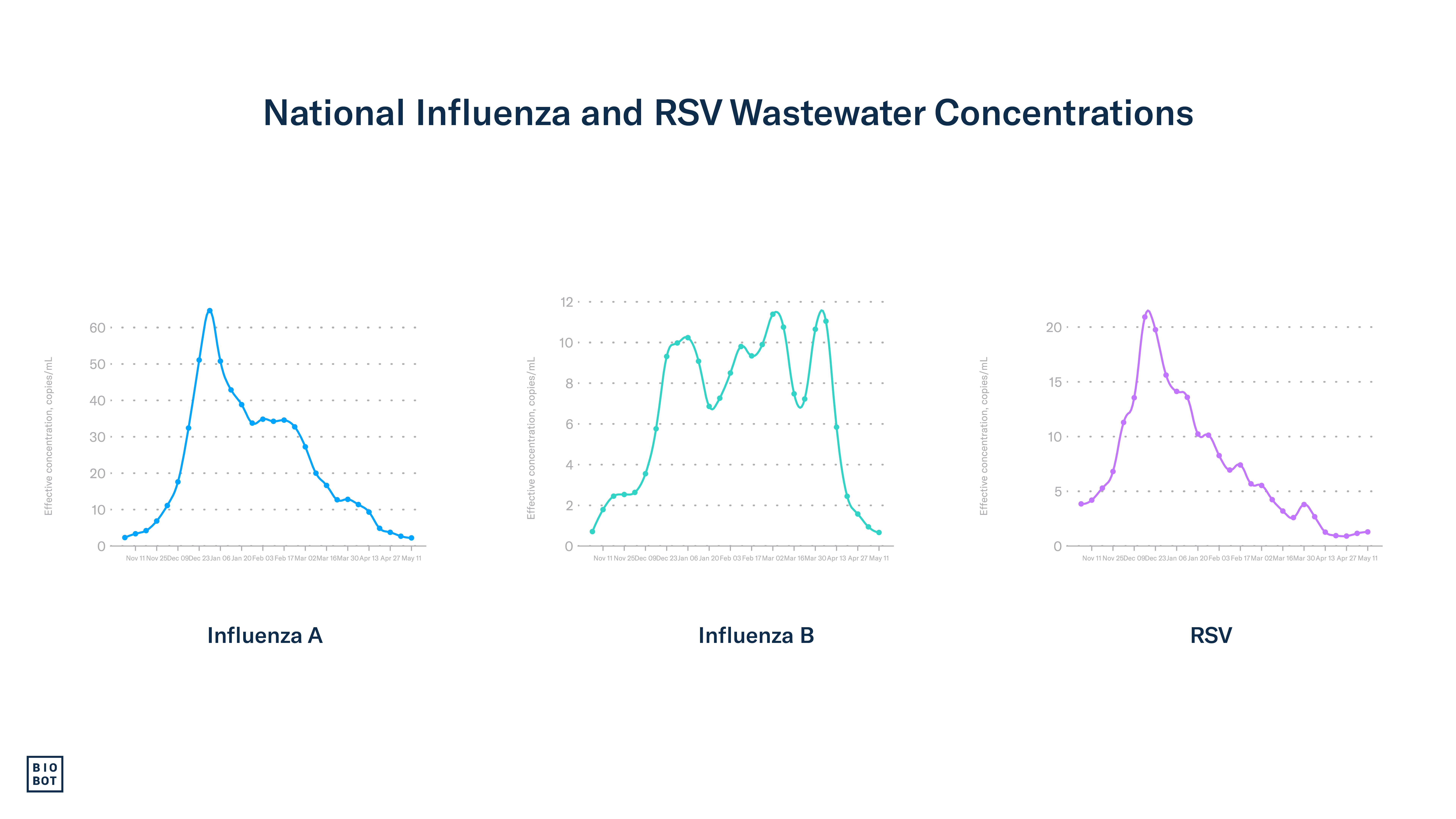
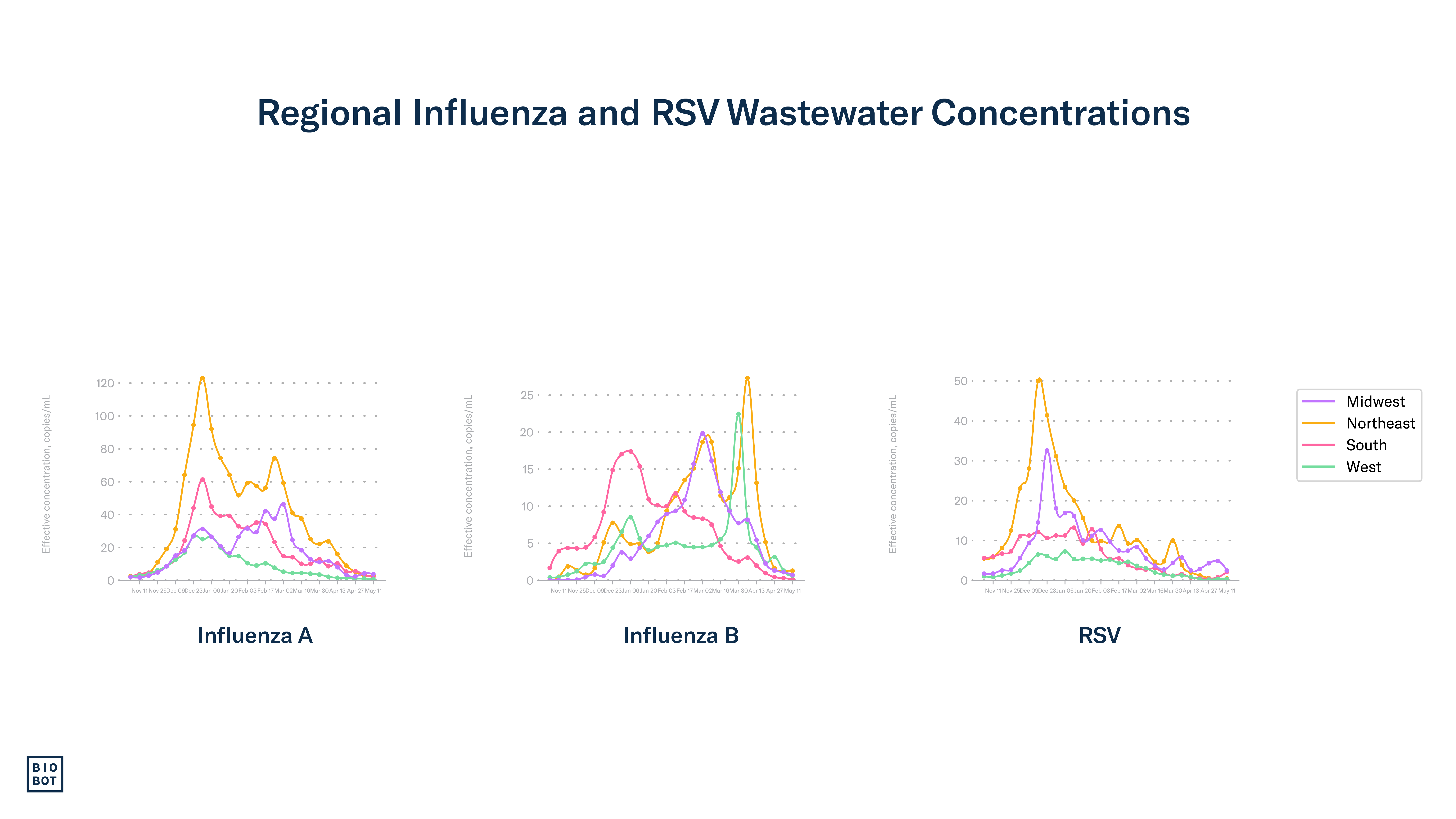
Data Note: Samples are collected from participating locations and processed by our lab team on a rolling basis. Each point on the figure represents the weekly average concentration from Sunday – Saturday (corresponding to the MMWR week), aligned to that week’s Saturday.
Contributors

Marisa Donnelly, PhD
Public Health Partnerships Epidemiologist

Max Imakaev, PhD
Data Scientist
Previous Risk Reports
Summary: Week of 5/13/24
We want to share the information that we have at the moment on the rapidly evolving H5N1 influenza virus situation. Biobot’s influenza A assay detects the H5N1 influenza subtype, which is an influenza A virus, but does not distinguish between the different subtypes of influenza A (e.g., H5N1 vs. H1N1). While we have not seen a widespread increase across the country in influenza A virus in recent weeks, we continue to see a slight uptick in influenza A concentrations in the Midwest. Thankfully, influenza A wastewater concentrations have continued to decrease in the South after we reported an uptick during week 17. We want to highlight some important points about the role of Biobot’s wastewater data in understanding the current circulation/risk of H5N1 in the South and nationally:
- At this point, we cannot determine if these upticks are due to seasonal influenza A virus or if H5N1 could be playing a role in the increase.
- Biobot is currently testing for influenza A in 7 out of the 9 states with positive dairy herds (Texas, New Mexico, Kansas, Idaho, Ohio, North Carolina, and South Dakota), among several other states across the country.
- Our current assays do not distinguish between human infections and infected animals that shed into the wastewater system.
This situation is rapidly evolving, and our team will continue to monitor H5N1 closely. We will provide any additional information as it becomes relevant or available via Twitter and in the risk reports.
Biobot’s national wastewater network showed declining national influenza A & B concentrations during week 19, while SARS-CoV-2 and RSV concentrations slightly increased. Nationally, major clinical metrics remain low for COVID-19, influenza, and RSV in week 18. The percentage of outpatient visits due to influenza-like illness (ILI) remains below the national baseline of 2.9%, currently at 2.1%. Overall, the illness burden due to respiratory viruses is currently low.
The Bottom Line: As we address the evolving H5N1 situation, leveraging every public health tool, including wastewater monitoring, is crucial for staying ahead of potential public health threats. This is especially important as national requirements for reporting hospitalizations due to COVID-19 and influenza ended on May 1st, 2024. It is important to understand that, currently, H5N1 does not pose a significant risk to human health. However, closely monitoring this situation is essential. Our recommendations to keep yourself and loved ones healthy remain the same: if you feel unwell, minimize contact with others, consider wearing a mask in crowded areas, and stay current with vaccinations and boosters. Taking these precautions can help keep you and your loved ones healthy.
National Outlook
RSV
The slight increase in RSV wastewater concentrations we began observing in week 18 continued into week 19. It appears that these increases are mostly driven by increases observed in the South. Overall, concentrations are low; however, they do indicate a bit of late-season activity. In good news, though, national clinical RSV metrics also continued to decline in week 18 and remained low.

Influenza
Nationally, influenza A & B concentrations decreased in week 19 and remain low. We continue to keep a close eye on influenza A concentrations as the highly pathogenic avian influenza virus (HPAI) H5N1 is an influenza A virus subtype that our assay picks up. Right now, we aren’t seeing any national increases in influenza A, which is great news.
Clinical data showed that the illness burden due to influenza continued to decline in week 18. Test positivity from clinical labs decreased from 3.9% to 3.1%. The percentage of outpatient visits for influenza-like illness (ILI) – typical in flu, RSV, and COVID-19 patients – held steady in week 18 and remains below the national baseline of 2.9%, currently at 2.1%. This is the first week that we don’t have any updates to hospitalizations data as the CDC has removed this from the public dashboard. At this point in time, it is unclear if public reporting of influenza hospitalizations will be reinstated for next year’s respiratory season. In its absence, hospitalization reporting from FluSurv-NET, an enhanced surveillance system covering 14 states, will be our best bet at understanding the hospital burden due to influenza. FluSurv-NET reports that the hospitalization rate per 100,000 persons for the US went from 0.7 in week 17 to 0.3 in week 18.
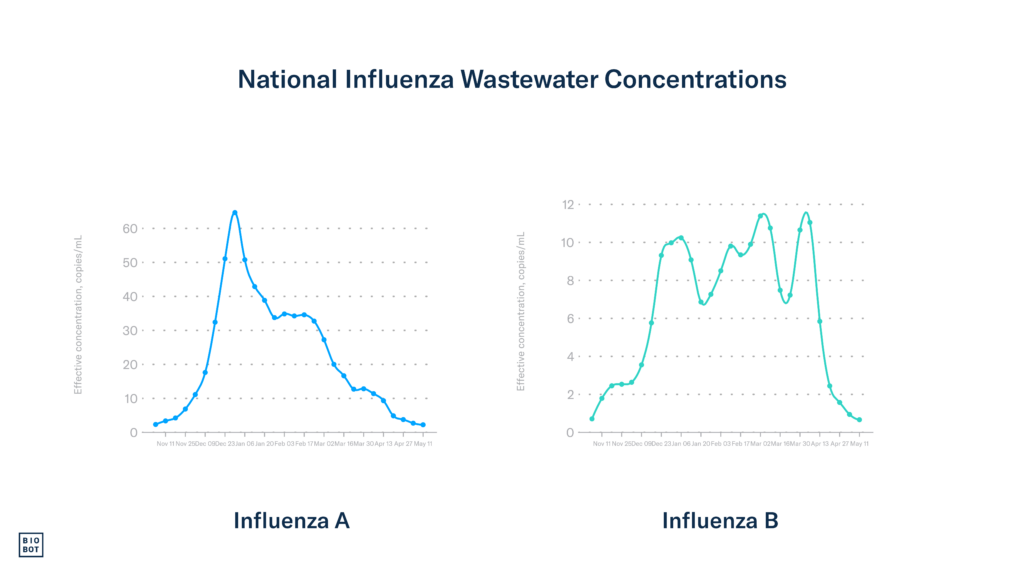
COVID-19
Wastewater data show that COVID-19 activity and community viral load slightly increased during week 19 but remained low overall. As of week 19, the national SARS-CoV-2 wastewater concentration average is 226 copies/mL.
Clinical metrics showed that the COVID-19 disease burden decreased nationally in week 18. Test positivity held steady in week 18, currently at 3.1%. Deaths due to COVID-19 also held steady and currently represent 0.7% of all deaths in the US. This is the first week that we don’t have any updates to hospitalizations data as the CDC has removed this from the public dashboard. At this point in time, it is unclear if public reporting of COVID-19 hospitalizations will be reinstated for next year’s respiratory season. In its absence, hospitalization reporting from COVID-NET, an enhanced surveillance system covering 13 states, will be our best bet at understanding hospital burden due to influenza. COVID-NET reports that the hospitalization rate per 100,000 persons in the US went from 1.2 in week 17 to 0.7 in week 18.
Regional
The South
RSV: In the South, RSV wastewater concentrations increased slightly but remained very low overall during week 19.
Influenza: We are happy to report that influenza A concentrations have declined over the previous two weeks through week 19 after a brief increase during week 17. This is especially good news in light of H5N1, an influenza A virus that we are paying close attention to. Influenza B concentrations have also declined and are now at the lowest levels we observed in the South since we began testing for it. Clinical data also shows good signs of low disease burden – most states in the South either held steady or experienced decreases in outpatient visits due to ILI during week 17. Exceptions to this were Oklahoma and Alabama, which experienced very small increases in ILI activity. All Southern states remain at the Minimum ILI activity level.
COVID-19: SARS-CoV-2 wastewater concentrations slightly increased in the South during week 19, currently at 162 copies/mL. With COVID-19 hospitalizations no longer required to be reported to the CDC, the public dashboard no longer shows state-level hospitalization data. However, two states in the South are in COVID-NET: Georgia and Tennessee. Both experienced decreases in COVID-19 hospitalization rates in week 18, and hospitalizations in the South remain low overall.
The Midwest
RSV: After a brief uptick in RSV concentrations observed in the Midwest during the past couple of weeks, concentrations have come back down in week 19. Corroborating what we’re observing in wastewater, RSV-NET reports that hospitalization rates due to RSV have increased slightly during the previous week in Minnesota, one of two Midwestern states in RSV-NET, along with Michigan. RSV hospitalization rates in Minnesota increased from 0.1 per 100,000 persons in week 17 to 0.2 in week 18. Despite this small increase, the hospitalization rate remains very low. While there appears to be some late-season RSV activity in the Midwest, we are getting back on track with decreasing RSV wastewater concentrations this week.
Influenza: Influenza B wastewater concentrations declined and remained low in the Midwest during week 19. However, wastewater concentrations for influenza A in week 19 held steady at a slightly elevated value compared to recent weeks. As stated before, we are paying close attention to influenza A metrics in light of the evolving H5N1 situation. Of note, Kansas, Michigan, Idaho, Ohio, and South Dakota are all Midwest states that have reported cattle herds positive for H5N1. Biobot currently samples and tests for influenza A in all of these states except Michigan. It is important to understand that while we are seeing a slight uptick, influenza A levels in the Midwest remain relatively low, indicating that influenza A circulation is not widespread. Clinical data shows good signs of decreasing illness burden due to influenza. All states in the Midwest experienced a decrease in outpatient visits due to IL in week 18. Additionally, all states in the Midwest have Low or Minimal ILI activity levels.
COVID-19: SARS-CoV-2 wastewater concentrations decreased in the Midwest during week 19, at 177 copies/mL. With COVID-19 hospitalizations no longer required to be reported to the CDC, the public dashboard no longer shows state-level hospitalization data. However, three states in the Midwest are in COVID-NET: Michigan, Minnesota, and Ohio. All experienced decreases in COVID-19 hospitalization rates in week 18, and COVID-19 hospitalizations in the Midwest remain low overall.
The Northeast
RSV: In the Northeast, RSV wastewater concentrations remained very low during week 19 and are currently the lowest values we’ve observed for the region since we began testing.
Influenza: Influenza A continued to decrease in the Northeast during week 19, while influenza B concentrations increased slightly. Concentrations for influenza A are similar to those in early November, and concentrations for influenza B are similar to those in early December. All states in the Northeast either held steady or experienced a decrease in the percentage of outpatient visits due to ILI in week 18. All Northeastern states are now in the Minimal ILI activity level.
COVID-19: SARS-CoV-2 wastewater concentrations slightly declined in the Northeast during week 19, currently at 289 copies/mL. With COVID-19 hospitalizations no longer required to be reported to the CDC, the public dashboard no longer shows state-level hospitalization data. However, three states in the Northeast are in COVID-NET: Connecticut, Maryland, and New York. Maryland and New York experienced decreased COVID-19 hospitalization rates in week 18, while Connecticut held steady. COVID-19 hospitalizations in the Northeast remain low overall.
The West
RSV: RSV wastewater concentrations remained low in the West during week 19 and are currently the lowest values we’ve observed for the region since we began testing.
Influenza: Wastewater concentrations for influenza A remained stable and very low in the West during week 19 and are at similar levels to those observed when we began testing in late October. Influenza B concentrations have also declined in week 19 in the South. Clinical metrics continue to somewhat fluctuate in the region but remain low overall. During week 18, most states held steady or experienced decreases in outpatient visits due to ILI, except Montana, Utah, Arizona, and Colorado, which experienced slight increases. In good news, though, all Western states remain in the Low or Minimal ILI activity levels.
COVID-19: During week 19, SARS-CoV-2 wastewater concentrations slightly increased in the West, currently at 233 copies/mL. Similar to influenza activity, the West continues to experience more fluctuations than other regions regarding clinical metrics. With COVID-19 hospitalization no longer required to be reported to CDC, the public dashboard no longer shows state level hospitalization data. Five states in the West are in COVID-NET: California, Colorado, New Mexico, Oregon, and Utah. California, Colorado, New Mexico, and Utah experienced decreases in hospitalization rates due to COVID-19 in week 18, while Oregon experienced a slight uptick. COVID-19 hospitalizations in the West remain low overall.

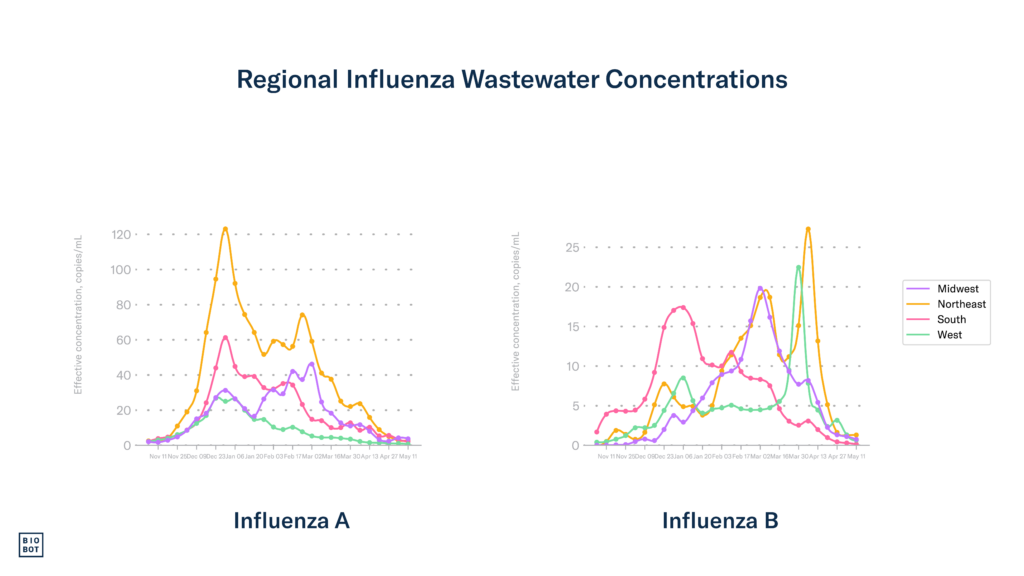
Footnotes:
Wastewater data from Biobot Analytics for RSV, influenza, and SARS-CoV-2 are through May 11, 2024 (MMWR week 19). Clinical data on testing, hospitalizations, and emergency department visits for RSV, influenza, and COVID-19 are from the Centers for Disease Control and Prevention. Updates to clinical data for RSV, influenza, and COVID-19 are through May 4, 2024 (MMWR week 18).





